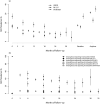The Association Between Heterosexual anal Intercourse and HIV Acquisition in Three Prospective Cohorts of Women
- PMID: 37392271
- PMCID: PMC10598156
- DOI: 10.1007/s10461-023-04115-y
The Association Between Heterosexual anal Intercourse and HIV Acquisition in Three Prospective Cohorts of Women
Abstract
The extent to which receptive anal intercourse (RAI) increases the HIV acquisition risk of women compared to receptive vaginal intercourse (RVI) is poorly understood. We evaluated RAI practice over time and its association with HIV incidence during three prospective HIV cohorts of women: RV217, MTN-003 (VOICE), and HVTN 907. At baseline, 16% (RV 217), 18% (VOICE) of women reported RAI in the past 3 months and 27% (HVTN 907) in the past 6 months, with RAI declining during follow-up by around 3-fold. HIV incidence in the three cohorts was positively associated with reporting RAI at baseline, albeit not always significantly. The adjusted hazard rate ratios for potential confounders (aHR) were 1.1 (95% Confidence interval: 0.8-1.5) for VOICE and 3.3 (1.6-6.8) for RV 217, whereas the ratio of cumulative HIV incidence by RAI practice was 1.9 (0.6-6.0) for HVTN 907. For VOICE, the estimated magnitude of association increased slightly when using a time-varying RAI exposure definition (aHR = 1.2; 0.9-1.6), and for women reporting RAI at every follow-up survey (aHR = 2.0 (1.3-3.1)), though not for women reporting higher RAI frequency (> 30% acts being RAI vs. no RAI in the past 3 months; aHR = 0.7 (0.4-1.1)). Findings indicated precise estimation of the RAI/HIV association, following multiple RVI/RAI exposures, is sensitive to RAI exposure definition, which remain imperfectly measured. Information on RAI practices, RAI/RVI frequency, and condom use should be more systematically and precisely recorded and reported in studies looking at sexual behaviors and HIV seroconversions; standardized measures would aid comparability across geographies and over time.
Keywords: Anal intercourse; HIV incidence; Heterosexual; Sexual behavior; Women.
© 2023. The Author(s).
Conflict of interest statement
The authors have no conflicts of interest to disclose. The funders had no role in study design, data collection and analysis, decision to publish, or preparation of the manuscript.
Figures



References
MeSH terms
Grants and funding
- R01AI057020 and UM1AI068619/NH/NIH HHS/United States
- UM1 AI068633/AI/NIAID NIH HHS/United States
- U01 AI069486/AI/NIAID NIH HHS/United States
- UM1 AI068615/AI/NIAID NIH HHS/United States
- UM1 AI106707/AI/NIAID NIH HHS/United States
- MR/R015600/1/MRC_/Medical Research Council/United Kingdom
- UM1 AI068614/AI/NIAID NIH HHS/United States
- U01 AI068635/AI/NIAID NIH HHS/United States
- U01 AI069415/AI/NIAID NIH HHS/United States
- UM1 AI068619/AI/NIAID NIH HHS/United States
- U01 AI068618/AI/NIAID NIH HHS/United States
- P30 AI036219/AI/NIAID NIH HHS/United States
- UM1 AI068618/AI/NIAID NIH HHS/United States
- U01 AI069421/AI/NIAID NIH HHS/United States
- UM1 AI068635/AI/NIAID NIH HHS/United States
- R01 AI057020/AI/NIAID NIH HHS/United States
- U01 AI068614/AI/NIAID NIH HHS/United States
- UM1 AI068617/AI/NIAID NIH HHS/United States
LinkOut - more resources
Full Text Sources
Medical
Miscellaneous

